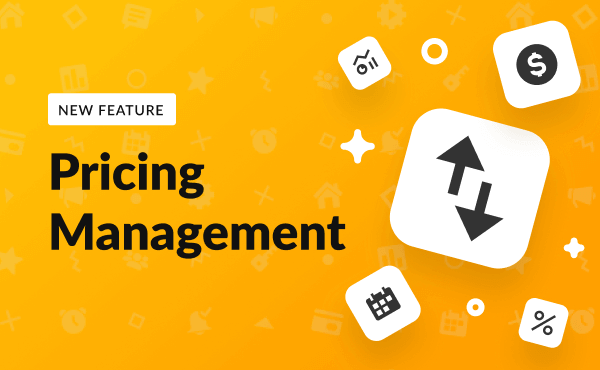How to Maximize Profitability with Per Accommodation Per Stay Pricing

If you plan to rent out Airbnbs or other vacation properties, you’ve probably heard of “per accommodation per stay” pricing. It’s a simple, transparent way to calculate the cost of a stay, which benefits both business owners and customers.
But how exactly does this method work—and will it make you a profit? In this post, we’ll answer your questions and some other commonly-used terms. Plus, we’ll show you some tried-and-true ways to maximize profitability.

Defining per accommodation per stay
You might be wondering what some of the accommodation pricing terms really mean. Let’s take a look.
What does resort fee per accommodation per stay mean?
A resort fee is an additional cost typically charged for hotel stays or vacation resorts. In most cases, it’s considered an additional amount covering any items, privileges, or amenities not included in the basic room rate.
The fee is levied at the owner’s discretion and may include anything from access to the pool, gym facilities, and activities for children to local telephone calls and internet access. This is sometimes described as a destination fee or amenity fee.
If a resort fee is charged per accommodation per stay, that means it’s levied for each room for each night you stay there. So, if a hotel charges a $40 resort fee per accommodation per night and a guest books one room for three nights, their total cost would be $120 on top of the basic price and taxes.
While some hotels provide resort fee information, explain what it covers, and answer queries about the fee, others aren’t so transparent. This is because US law does not require a resort or hotel to mention resort fees at the start of the booking process (although, if your property is based in another country, such as U.K. or Canada, it’s best to check local laws). Guests may also be able to avoid paying this additional fee if they tell the hotel they don’t want the extras.

Image Sourced from Nerdwallet.com
What is the meaning of per accommodation?
Per accommodation is a pricing model commonly used in hospitality and tourism. It typically refers to the cost of a single night’s stay in the form of accommodation, such as a hotel room or a vacation rental property. Guests usually pay per room or property per night or week, for some rentals.
Prices are charged based on a specific number of guests staying in the same room or property per night. For example, the price of a hotel stay typically covers two people sharing. If a single person wants the room, the fee is the same, and they’ll cover the cost themselves. For a vacation cabin that sleeps six people, the fee is based on that number, even if only four people use it.
Per accommodation prices vary based on factors such as location, time of year, and level of demand. As well as the basic rental fee for the accommodation, this may include additional amenities or services.
While per-person rates don’t often come into it, you may have noticed that Airbnb fees may change according to occupancy. Some listings have a base fee for a set number of people, and then they’ll charge extra per person afterward. For example, an owner might charge $100 per night for one guest plus an extra $25 for each additional guest.
What does deposit per accommodation mean?
At vacation rentals, guests are usually asked to pay a security deposit at the start of their stay to cover any damage. If the property and contents are undamaged at departure, they should get this AirBnB fee back. Hotels often charge a deposit for the same reason, and in case people steal the towels or robes.
Deposit per accommodation usually means that one deposit is charged per room or property, not per person. Guests may pay in cash, or the owner may take credit card details but only charge the card if property damage occurs. You may also ask travelers for a deposit to hold the reservation, with the total balance paid at the end of the stay.
Maximizing profitability with per accommodation per stay pricing
To maximize profitability, business owners need to find a balance between charging enough to make money and setting fees that customers find acceptable. The good news is that the per accommodation per stay pricing model is pretty straightforward, which makes it easier for you to adjust it as needed.
Determine your optimal base price
Your base price is the price of the accommodation without any add-ons.
To find the optimal number, consider what you’ll need to charge to cover your costs and make the desired profit.
For example, if you’re pricing a vacation rental, you need to factor in:
- Property maintenance.
- Cleaning and laundry services.
- Energy bills (higher in winter).
- Pool/garden maintenance.
- Mortgage payments.
- Insurance coverage.
- Advertising and marketing expenses.
- Various taxes depending on the location of your rental.
- Property management or agent fees.
- A contingency budget for damage or repairs over time.
Figure out your break-even point after all these costs have been accounted for, and use this as your base price. It’s a good idea to keep track of expenses and admin by using real estate accounting software specifically designed for rental businesses and real estate companies.
Ideal for landlords and estate agents, cloud-based tools like this make it easier to track expenses from different properties and file property taxes in one location. Crucially, for vacation rentals, there are also options that allow for multi-currency bank accounts and invoicing, making it easier to manage your property’s finances wherever you are.
With access to accurate data, you can then make better-informed decisions. You can adjust the base fee depending on your location or the sizes of your properties or rooms and offer varying rates to attract different guest segments.
Adjust prices based on seasonal and cyclical changes
Seasonality is a significant factor in pricing. Your property might be more popular at certain times of the year, depending on the location and amenities—and you can adjust the fees accordingly. For instance, rentals in mountain resorts would be more expensive during ski season, but you can offer lower fees to make sure you boost occupancy in summer.
Weekends, public holidays, and school vacation periods are generally more popular, so customers will expect to pay more for rentals on those dates. If a festival or a special event is happening nearby, you can also increase your fees for the duration, so remember to check local calendars.
This demand-based strategy involves forecasting, so you’ll need to look at current trends and the historical performance of your property. If you took a significant number of bookings last fall, you could reasonably expect the same again this year unless the market has changed.
Offer discounts and promotions to boost booking rates
Everyone loves a deal—and you can bet your target customers are shopping around to find one. But figuring out how to offer discounts without sacrificing profits is crucial. Plus, you don’t want potential customers thinking, “What’s the catch?”, nor do you want to attract the types of guests who’ll trash the place.
Many properties and hotels offer an early-bird discount for people who book by a specific date, which helps you to lock in bookings for the upcoming season. But if you’re trying to shift the remaining accommodation, you can reduce fees for last-minute bookers.
You could also apply discounts for booking multiple rooms or properties and provide a loyalty or referral scheme for regular bookers. They might collect points or get money off a return visit. You can also give people the option to pay a lower fee for booking at a non-refundable rate. This means you still get the money even if they cancel, as well as potentially re-selling the accommodation.
Another strategy is to partner with other local businesses and services to offer promotions. If there’s a bar or restaurant, fitness center, or transport rental company close to the vacation property, arrange discount coupons for your guests. You’ll get a commission for every guest you send their way, and travelers will appreciate the inspiration for places to visit.
Assess market demand and target competitive prices
As well as basing prices on the attributes of your property, such as location or available amenities, you also need to think about the wider market and strategies of your competitors. Nobody’s suggesting that you flat-out copy their pricing. But keeping an eye on it gives you a useful indication of what guests are willing to pay.
You have to make sure that your fees are not too far above or below the market average and that your offering represents the best value to travelers. That’s why it’s best not to get into a price war or a “race for the bottom” with your competitors. Instead, the answer is in providing a unique service or experience that they don’t offer.
For example, most hotels base their prices on two people sharing, which means that solo travelers usually get hit with an extra fee for occupying a two-person space. Given the growing popularity of solo travel, you could decide to target this market and offer accommodation at a fair price for single travelers (you could make up any shortfall with add-ons, as discussed below).

Image Sourced from travel.radicalstorage.com
Create customizable packages and offer add-ons
Travelers appreciate flexibility. You could let people choose how many days they stay at your property, rather than having a minimum length or insisting that they rent from Saturday to Saturday. They might also want to arrive or depart outside of typical check-in and check-out times to fit in better with their travel and transport plans.
Instead of charging a sneaky destination fee, allow guests to select the extras they want, such as internet access, a daily newspaper, or an in-room safe. You might offer the option of upgrading to a superior room or property or suggest airport transfers, shuttle buses to the town or beach, and tours of the area—all for an optional additional charge.
With that in mind, it’s always best to be transparent about additional expenses. Pricing them separately from the basic cost is also a psychological marketing strategy called partitioned pricing or drip pricing. People perceive the base rate and the extras as two different things, not as one large total cost.
Reduce operational costs
One way to maximize profitability is to reduce the cost of running your properties. Charging security deposits covers you for any damage and avoiding bargain-basement prices can help you attract trustworthy guests. If you encourage people for long-term stays, you’ll reduce the costs associated with changeovers.
You can also save money if you negotiate the best deals for things like cleaning services and property agent fees.
Here, the right tools will help you increase efficiency in admin tasks, such as financial reporting and customer inquiries. With data gathered from enterprise resource planning software, you can spot ways to streamline operations and save money by having all the data in one place.
In addition, you could set up automation for suggesting add-ons, processing payments, and handling check-ins and check-outs—plus a chatbot to answer FAQs. Meanwhile, dynamic pricing tools monitor market conditions and competitors in real time and allow you to optimize your rates accordingly.
Minimize over and underbooking
You might not think that either over- or underbooking would be a desirable option, but overbooking is a known tactic.
Hotels allow guests to book more rooms than are actually available so that when some inevitably cancel, they’ll still enjoy high occupancy. That said, if the predicted cancellations don’t happen, you’ll have to turn people away (even if they’ve paid a deposit).
Underbooking can occur when business owners advertise different accommodations on each distribution channel, usually to appeal to various audience segments. The risk here is that one channel could sell all its rooms and start turning people away, while other properties remain unsold on another platform.
When you’re charging per accommodation per stay, rather than per person, you’ll still get paid the total fee even if the property or room is under-occupied. But with an Airbnb room, you can charge an extra fee per guest on top of the base rate, so it makes sense not to have underoccupancy.
Final thoughts
Per accommodation per stay pricing strategies are simple to calculate, offer a transparent structure for customers, and can easily be adjusted for market conditions.
Using this as a base price gives you the option of charging for add-ons if people want them, rather than building them into an inflated fee from the start. When your fees are seen as fair, you can attract more guests and build a loyal customer base.
It’s important that you keep a close eye on local market trends, customer preferences, and competitor strategies. But beware of price wars—it’s easier to offer reduced rates and special offers if you’re starting from a higher price point in the first place.
About the Author
Ryan Grundy is an experienced writer of business content, with a background that spans both brand and marketing agencies. He has helped tech businesses find the right words across a range of formats, from web and social to campaigns and concepts.





![Your Monthly iGMS Roundup [February 2020]](/content/images/size/w600/wordpress/2020/02/igms-roundup-feb-2020-cover.png)

